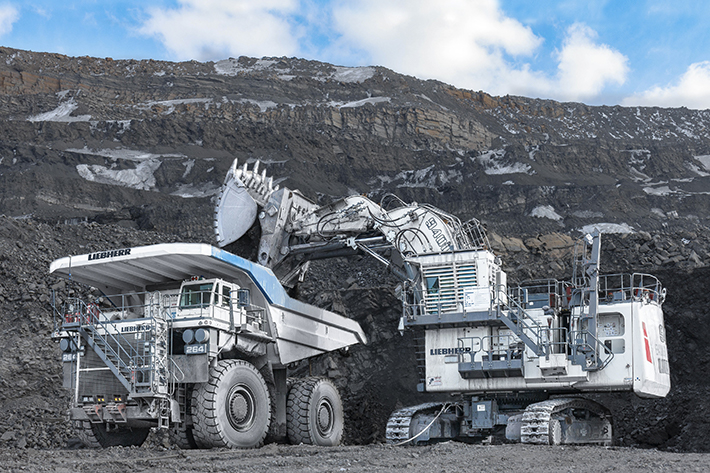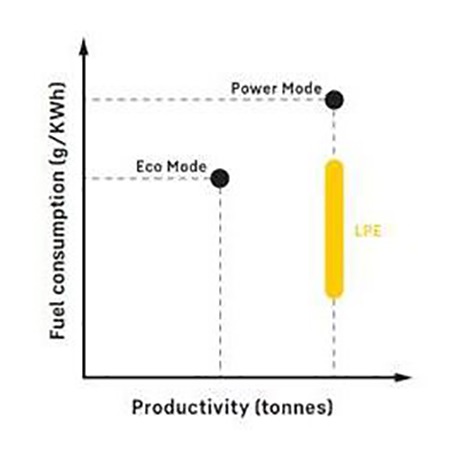
The global mining industry has demonstrated its commitment to cut greenhouse gas (GHG) emissions in support of the Paris Agreement, with many major mining houses announcing decarbonisation targets over the past 18 months. This increased focus on GHG emission reduction has accelerated the implementation of Liebherr’s existing low carbon solutions and triggered future projects to offer completely fossil fuel free mining equipment options. Liebherr Mining’s strategy to reduce GHG emissions will mainly focus on the operational phase of their machinery, as studies showed that more than 90% of GHG emissions over the complete lifecycle of the equipment occurred during this phase.
Liebherr Mining’s Zero Emission Program, which was established to develop these future solutions, is well aligned with the values of the Liebherr Group as an independent and responsible, family-owned company.
The Liebherr Group has existing in-house core competencies, across all 13 product segments, in electrification, batteries, internal combustion engines, injection systems and alternative renewable fuels. Building from this experience, the Zero Emission Program has clear targets and a roadmap to achieve low carbon solutions for the full range of off-highway trucks and excavators in 2022, and fossil fuel free solutions for the majority of applications by 2030.
The Zero Emission Program strives to deliver long-term sustainable products and services, providing different options centred on environmental sustainability, safety, cost, flexibility, and maintainability. Modularisation, along with an energy type agnostic approach to drivetrains, are key elements in Liebherr Mining’s strategy, easing the transition for customers with the possibility to retrofit modules.
2022 target: Liebherr’s low carbon emission technology
Liebherr Mining has developed and offered electrification solutions for many years and is now about to finalise all initiatives to achieve its first 2022 target to offer low carbon emission solutions for its complete digging and hauling range. The technologies, including the haul truck Trolley Assist System and electric excavator range, are consistently achieving proven results in the field to lower carbon emissions. The newly introduced in-built Liebherr Power Efficiency control system has also shown excellent results since field operation began in 2019.
Trolley Assist System for Liebherr haul trucks
With the T 264 trolley components production ready in 2022, all Liebherr trucks will be available with Trolley Assist System, providing a low emission solution for customers.
The Liebherr Trolley Assist System is an effective first step on the road to zero emission mine sites of the future. Utilising an overhead pantograph or trolley bars to connect the electric-drive system to the electrical network, the Trolley Assist System offers increased truck fleet productivity, or reduction in fleet size, while maintaining yearly production when compared with standard trucks. A significant reduction of diesel fuel consumption is also made possible with the Trolley Assist System along with a reduction of the truck fleet CO2 emissions. However, this of course depends on the percentage of renewable energy content in the grid supplied power.
Liebherr delivers proven field experience with 39 T 284 units fitted with the Trolley Assist System currently in operation on two different sites, with more to be commissioned in 2022. Liebherr is also the first company to run a 100 t truck under trolley, with a fleet of T 236 trucks running on a 5 km trolley line in Austria – the longest trolley line in the world.
The largest range of electric excavators
The Liebherr Group has over 30 years of experience in electric driven machines for earthmoving, material handling and mining applications. Today, Liebherr Mining is the OEM that offers the largest range of electric driven excavators on the market. Ranging from 130 t to 800 t, the R 9150, R 9200, R 9250, R 9350, R 9400, and R 9800 are all available as electric drive versions. The electric drive R 9600 will soon be available.
Liebherr electric excavators are existing and already proven solutions helping customers to build future sustainable mine sites. Focusing on reliability, maintainability, and maximum safety, Liebherr’s engineering teams strive for solutions requiring minimum change to existing energy infrastructure and operational behaviour on customer sites. Thanks to 70% of parts commonality with diesel versions, Liebherr also offers complete retrofit options for existing machines.
To offer better machine mobility and safety for the workforce on site, Liebherr has developed a cable reel option for all electric drive excavators either in backhoe or face shovel. The cable reel is completely autonomous and has a capacity up to 300 m depending on the excavator type. Furthermore, Liebherr proposes an operational concept for excavators with cable reel in backhoe application, particularly in double benching operations.

Move more for less: Liebherr Power Efficiency
Liebherr is continuously improving and upgrading its standard machines to enable the transition to emission reductions. Liebherr Power Efficiency (LPE) is the most recent built-in technology upgrade making this productivity and sustainability contribution.
Starting with Generation 7, all Liebherr mining excavators will be equipped with Liebherr Power Efficiency (LPE) as standard. This specific engine and hydraulic management system drastically reduces fuel consumption by up to 20%.
The system:
– adapts piloting processes according to operator requirements
– electronically controls pressure and oil flow
– has increased efficiency of the control valves and the new Liebherr pumps
– has a fully integrated engine control system
– reduces hydraulic losses and load profile of the engine for increased component lifetime
– reduces energy consumption without impact on the machine performance
Based on constant research and development, Liebherr is able to provide size-equivalent machinery with higher production rates and less fuel consumption.
In fact, the combination of LPE together with the improved productivity of the R 9600 has shown 29% less fuel consumption per tonne of produced material over a one-year production study, compared to its predecessor, the R 996B. Expressed in fuel efficiency, tons per litre, this corresponds to a 40% better utilisation of the fuel.
These outstanding efficiencies allow Liebherr excavators to set new benchmarks in their respective classes and are a very important enablers for any kind of future drive train, as they significantly reduce the effort for cable handling or refuelling and storage of alternative fuels.

Pathway to Zero Emission solutions
As second step, Liebherr is now targeting to offer completely fossil fuel free mining equipment for hauling, digging, and dozing by 2030. This development will take into consideration the GHG emissions over equipment’s full lifecycle, as well as the overall well-to-wheel energy ecosystem. The company is also taking into account the operational mining process conditions that influence the right energy type choice.
Liebherr will develop three drivetrain options to achieve near zero emissions for its off-highway trucks: battery power module, internal combustion engines powered by renewable fuels, and H2 fuel cell-battery power module.
Drivetrain electrification through battery combined with trolley assist is already underway.
Despite some challenges, Liebherr sees also an opportunity that the propulsion energy can be provided by using hydrogen fuel cell-battery hybrids.
Research and development for internal combustion engines operating with renewable-based alternative fuels is progressing very well within the Liebherr Group, with Hydrogenated Vegetable Oil (HVO) as an approved fuel for machines powered by Liebherr engines as a first step. Hydrogen combustion engines are also currently being tested in Liebherr’s factory in Switzerland. The methanol combustion process has been developed for large displacement engines and is ready to move towards serial engine industrialisation based on market demand. Additionally, the ammonia combustion process is under investigation, with Liebherr seeing high potential in the usage of ammonia for heavy mobile, high energy demanding machines and gensets.
Liebherr mining excavators and dozers will also both have the option to be powered by internal combustion engines running on alternative fuels, along with the already existing electric drive version for excavators.
To achieve near zero emissions for the mining dozer and excavator, it is also crucial to utilise the most efficient drive system to reduce fuel consumption. The Liebherr hydrostatic drive system already achieves up to 20% improved fuel efficiency compared to mechanical competitor products. Despite this, Liebherr is currently in the process of comparing efficiency of an electric drive on a dozer prototype with hydrostatic drive efficiency. Given Liebherr’s expertise in both hydrostatic and electric AC drive systems, the company is in best position to choose the most appropriate option for the best drive system for the near zero emission solution.
To accelerate the process and ensure the best solutions will be offered, Liebherr is partnering with industry experts for their Zero Emission Program. ABB, a leader in power and automation technologies, develops state-of-the-art technology and equipment for overall electrification of mine sites and supports our customers and Liebherr with a particular focus on trolley assist infrastructure deployment. ENGIE, the global reference in renewable hydrogen, low-carbon energy, and services, will jointly with Liebherr evaluate the different renewable energy solutions, in particular renewable hydrogen and hydrogen-derived fuels, for loading, hauling, and dozing processes. This cooperation ensures that an integrated well-to-wheel approach is basis to define the best solutions for the mining industry.
With concept studies nearly finalised for trolley-battery hybrid, and ammonia and methanol for internal combustion engines, Liebherr expects to undertake field validation from 2024-2026, followed by the integration of proven fossil fuel free solutions from 2026-2030 into the entire range of mining machines.






